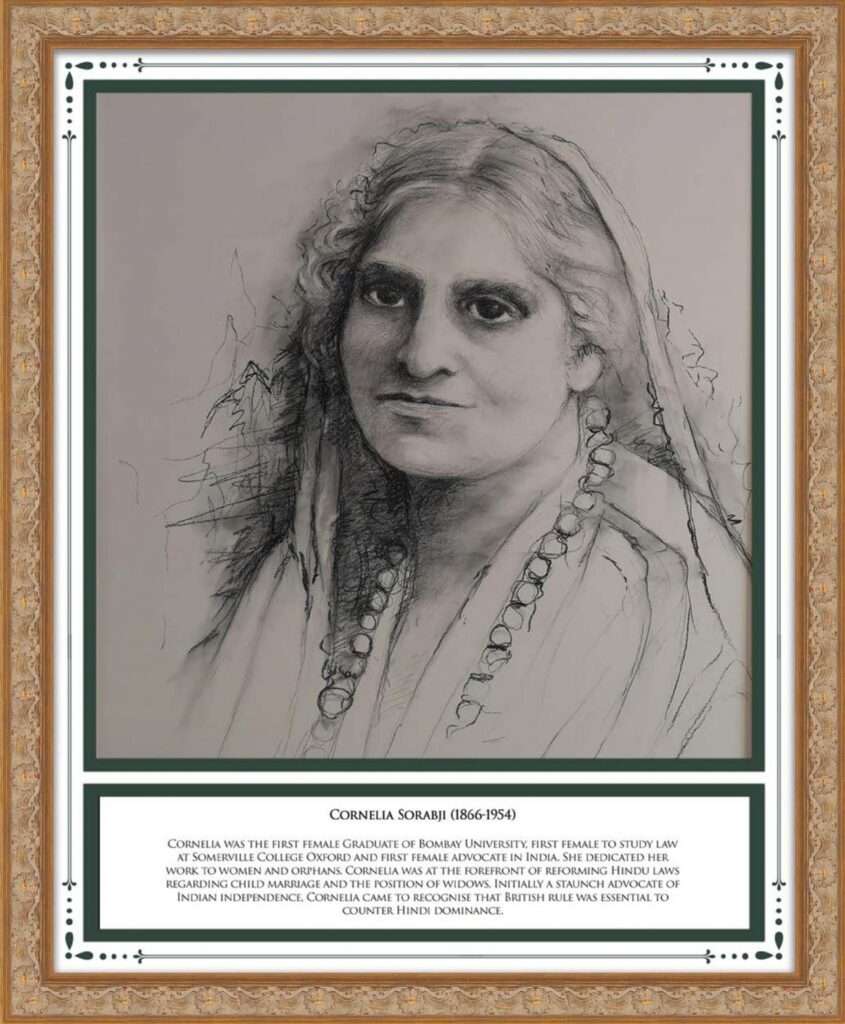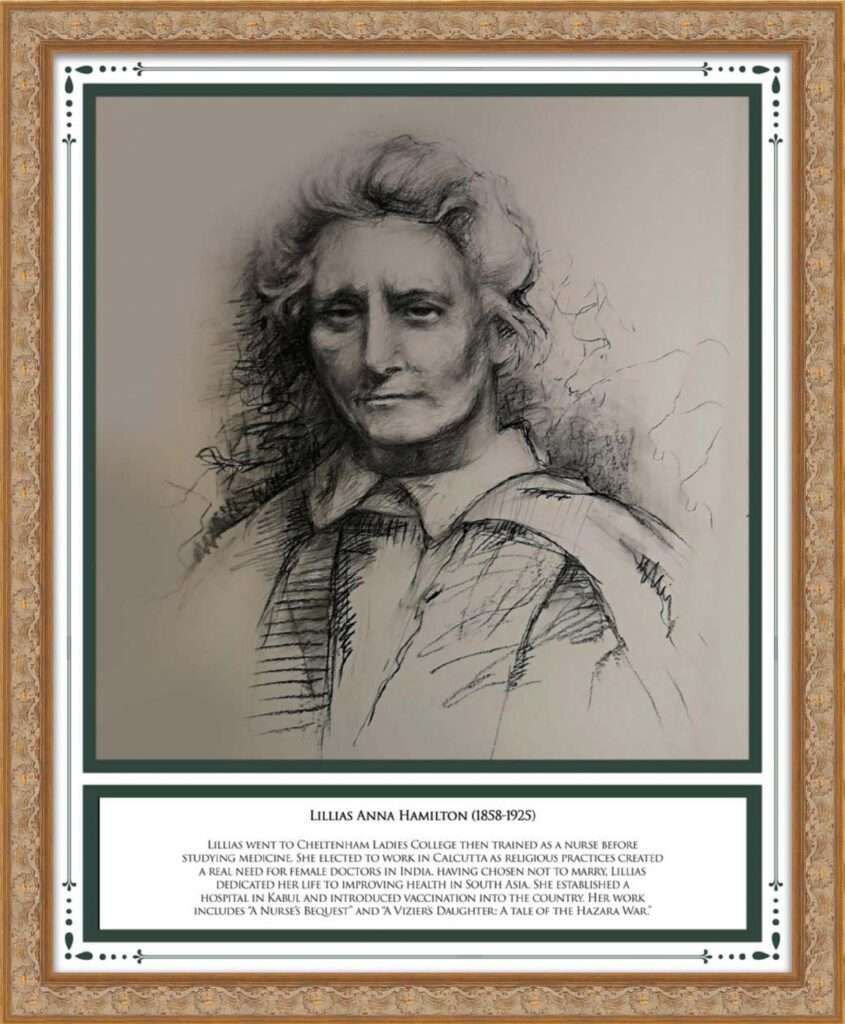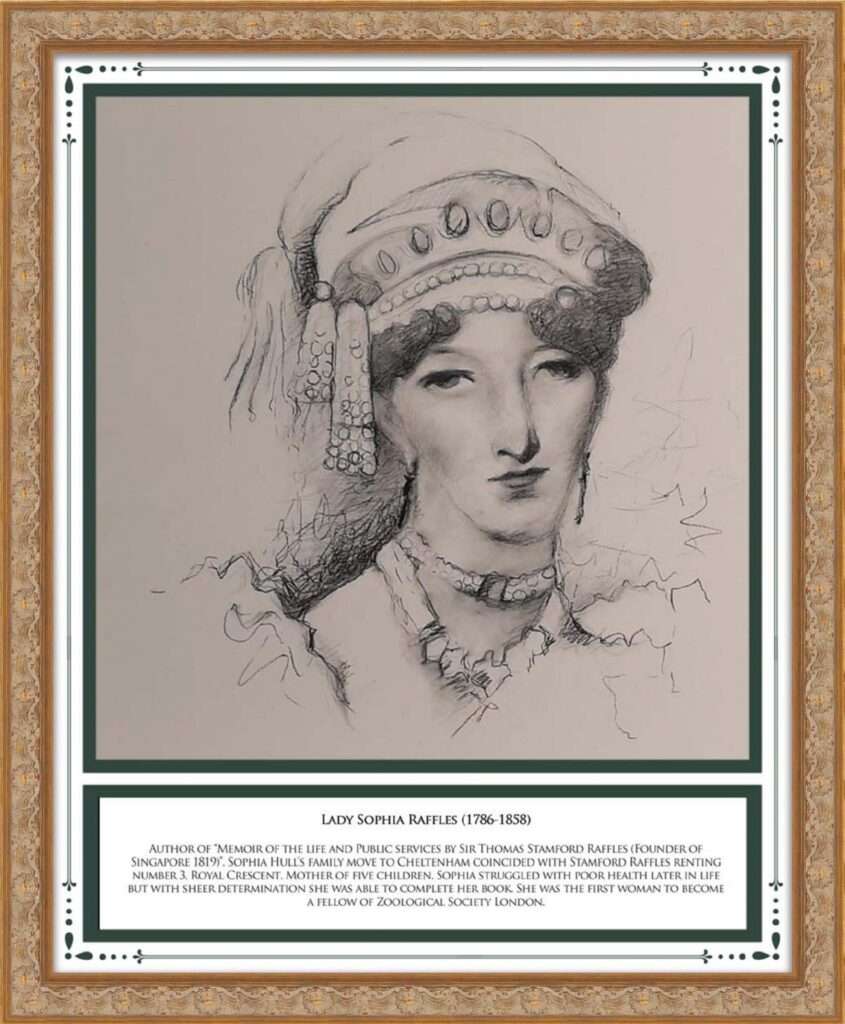The History of the Memsahibs
The word Memsahib comes from the word ”sahib”, used in India. Under the British Raj, the word used for the female equivalent was adapted to memsahib, a variation of the English word “ma’am” added to the word sahib.
On the walls of our restaurant, you will see portraits of five Memsahibs, chosen for their outstanding achievements and their links to Cheltenham. Below you’ll find further reading on the lives and history of those five Memsahibs.
The History of the Memsahibs
The word Memsahib comes from the word ”sahib”, used in India. Under the British Raj, the word used for the female equivalent was adapted to memsahib, a variation of the English word “ma’am” added to the word sahib.
On the walls of our restaurant, you will see portraits of five Memsahibs, chosen for their outstanding achievements and their links to Cheltenham. Below you’ll find further reading on the lives and history of those five Memsahibs.
Pandita Ramabai Sarasvati
The daughter of a Marathi Brahman scholar, Pandita Mary Saraswati Ramabai lost her parents and sister in the 1876-7 Indian Famine. Taught Sanskrit by her father who believed in the education of women, Ramabai was honoured with the title Saraswati, after the goddess of learning. Awarded by Calcutta University for her Sanskrit scholarship and her earnest but witty lectures on social questions. The only woman who has been permitted to call herself Pandita, in 1881 Ramabai was widowed with a daughter from her two-year marriage to a Bengali lawyer.
Ramabai came to Britain in 1883 to start medical training. She studied at Cheltenham Ladies’ College in 1884, where she taught the girls Sanskrit in return. Ramabai was made welcome by the redoubtable headmistress, Dorothea Beale, and regularly attended her lectures. On a visit to the Women’s Medical college in Philadelphia in 1887, Ramabai was inspired to devote the rest of her life to the protection and education of Hindu widows. Especially those who had been child brides, whose cruel treatment she was only too aware of. She became one of India’s most influential social reformers and writers. She wrote The Hindu High Caste Woman (1887), the first book by an Indian woman to appear in English. On her return to India Ramabai founded the Mukti mission, which has helped countless destitute women and girls. In 1919 Pandita Ramabai was awarded the Kaisar-i-Hind medal for her work.

Pandita Ramabai Sarasvati
The daughter of a Marathi Brahman scholar, Pandita Mary Saraswati Ramabai lost her parents and sister in the 1876-7 Indian Famine. Taught Sanskrit by her father who believed in the education of women, Ramabai was honoured with the title Saraswati, after the goddess of learning. Awarded by Calcutta University for her Sanskrit scholarship and her earnest but witty lectures on social questions. The only woman who has been permitted to call herself Pandita, in 1881 Ramabai was widowed with a daughter from her two-year marriage to a Bengali lawyer.
Ramabai came to Britain in 1883 to start medical training. She studied at Cheltenham Ladies’ College in 1884, where she taught the girls Sanskrit in return. Ramabai was made welcome by the redoubtable headmistress, Dorothea Beale, and regularly attended her lectures. On a visit to the Women’s Medical college in Philadelphia in 1887, Ramabai was inspired to devote the rest of her life to the protection and education of Hindu widows. Especially those who had been child brides, whose cruel treatment she was only too aware of. She became one of India’s most influential social reformers and writers. She wrote The Hindu High Caste Woman (1887), the first book by an Indian woman to appear in English. On her return to India Ramabai founded the Mukti mission, which has helped countless destitute women and girls. In 1919 Pandita Ramabai was awarded the Kaisar-i-Hind medal for her work.


Begum Frances Johnson
Married to the East India Company’s Chief at Cossimbazaar, the already twice widowed and heavily pregnant Frances, then Mrs Watts, escaped imprisonment in 1757 with her children through the help of a senior Mughal lady. A story she liked to tell in later years. Later and exceedingly wealthy, the family returned to England where Watts built Berkshire’s South Hill Park. Following his death in 1764, and most unusually for the day, Frances returned alone to India. At this time (around 1769) the journey would have taken several months around the Cape of Good Hope; it is unknown why she wanted to leave her children in England to return to India.
She then entered a fourth disastrous marriage with an English clergyman in 1774, the Reverend William Johnson. Her support enabled him to campaign for a new church, St Johns, ultimately to be designed and built by Lieutenant James Agg of Cheltenham. When this husband decided to return to England, Frances elected to separate and remain in Calcutta with her slave girls. She was undoubtedly a society favourite. Frances Johnson died in Calcutta in February 1812 aged 83, she chose to be buried in St John’s churchyard in Calcutta. Her memorial states “The Oldest British Resident in Bengal, universally beloved, respected and revered”.
Begum Frances Johnson
Married to the East India Company’s Chief at Cossimbazaar, the already twice widowed and heavily pregnant Frances, then Mrs Watts, escaped imprisonment in 1757 with her children through the help of a senior Mughal lady. A story she liked to tell in later years. Later and exceedingly wealthy, the family returned to England where Watts built Berkshire’s South Hill Park. Following his death in 1764, and most unusually for the day, Frances returned alone to India. At this time (around 1769) the journey would have taken several months around the Cape of Good Hope; it is unknown why she wanted to leave her children in England to return to India.
She then entered a fourth disastrous marriage with an English clergyman in 1774, the Reverend William Johnson. Her support enabled him to campaign for a new church, St Johns, ultimately to be designed and built by Lieutenant James Agg of Cheltenham. When this husband decided to return to England, Frances elected to separate and remain in Calcutta with her slave girls. She was undoubtedly a society favourite. Frances Johnson died in Calcutta in February 1812 aged 83, she chose to be buried in St John’s churchyard in Calcutta. Her memorial states “The Oldest British Resident in Bengal, universally beloved, respected and revered”.

Cornelia Sorabji
Cornelia Sorabji, the first female graduate of Bombay University, came to Britain to study law at Somerville College, Oxford with the help of the National Indian Association. She was the first woman to do so. Having graduated she returned to India where she started her work with women and orphans, work that continued for many years. She often worked alongside her friend Pandita Ramabai. Social reform for women was high on her agenda, especially the reform of Hindu laws regarding child marriage and the position of widows. She believed that social change would never succeed until the majority of illiterate women had access to education.
However, despite the British Law degree, she was unable to practise as fully as she would have liked. In 1924 women in India were allowed to practice law, and Sorabji, finally recognised as a barrister, began working in Kolkata. Due to discrimination from male colleagues she was restricted to preparing case opinions rather than arguing before courts.
Initially a staunch advocate of Indian Independence, Cornelia came to recognise that British Rule was essential to counter Hindi dominance. She retired to London, having been the first female advocate in India.

Cornelia Sorabji
Cornelia Sorabji, the first female graduate of Bombay University, came to Britain to study law at Somerville College, Oxford with the help of the National Indian Association. She was the first woman to do so. Having graduated she returned to India where she started her work with women and orphans, work that continued for many years. She often worked alongside her friend Pandita Ramabai. Social reform for women was high on her agenda, especially the reform of Hindu laws regarding child marriage and the position of widows. She believed that social change would never succeed until the majority of illiterate women had access to education.
However, despite the British Law degree, she was unable to practise as fully as she would have liked. In 1924 women in India were allowed to practice law, and Sorabji, finally recognised as a barrister, began working in Kolkata. Due to discrimination from male colleagues she was restricted to preparing case opinions rather than arguing before courts.
Initially a staunch advocate of Indian Independence, Cornelia came to recognise that British Rule was essential to counter Hindi dominance. She retired to London, having been the first female advocate in India.


Lillias Anna Hamilton
Lilias Hamilton was born in Australia in 1858 to a Scottish farming family. After extensive travelling the family arrived in Cheltenham in 1874, where Lilias attended the Ladies’ College. After training as a nurse 1883, Lilias studied medicine at London and Edinburgh, acquiring her medical degree in Brussels. Inspired by Colonel Joubert, of the Indian Medical Service, Lilias went to practise in India, where there was a desperate need for female doctors. Lilias established her own successful private medical practice in Calcutta, also holding the post of medical officer at the Lady Dufferin Zenana (women’s) Hospital. In 1894 she travelled to Kabul, where she became personal physician to the Amir, Abdur Rahman Khan, for three years. Lilias established a hospital in Kabul and introduced vaccination into Afghanistan.
Lilias returned to England in 1896, co-founding the Victoria Women’s Settlement in Liverpool the following year. She then set up a nursing home in London and returned to private practice. Ever the traveller, she also established a farm in the Transvaal Province (South Africa) with her brother. In 1908 Lilias became warden of Studley College in Warwick, established in 1898 to train women in agriculture and horticulture. She was an active member of the Women’s Freedom League and attended many suffragette meetings. During the First World War, Lilias served in a typhoid hospital in Podgoritza, Montenegro, under the auspices of the Wounded Allies Relief Committee. She returned to Studley, until ill-health forced her to retire in 1924. Lilias died in 1925 in Nice.
Lillias Anna Hamilton
Lilias Hamilton was born in Australia in 1858 to a Scottish farming family. After extensive travelling the family arrived in Cheltenham in 1874, where Lilias attended the Ladies’ College. After training as a nurse 1883, Lilias studied medicine at London and Edinburgh, acquiring her medical degree in Brussels. Inspired by Colonel Joubert, of the Indian Medical Service, Lilias went to practise in India, where there was a desperate need for female doctors. Lilias established her own successful private medical practice in Calcutta, also holding the post of medical officer at the Lady Dufferin Zenana (women’s) Hospital. In 1894 she travelled to Kabul, where she became personal physician to the Amir, Abdur Rahman Khan, for three years. Lilias established a hospital in Kabul and introduced vaccination into Afghanistan.
Lilias returned to England in 1896, co-founding the Victoria Women’s Settlement in Liverpool the following year. She then set up a nursing home in London and returned to private practice. Ever the traveller, she also established a farm in the Transvaal Province (South Africa) with her brother. In 1908 Lilias became warden of Studley College in Warwick, established in 1898 to train women in agriculture and horticulture. She was an active member of the Women’s Freedom League and attended many suffragette meetings. During the First World War, Lilias served in a typhoid hospital in Podgoritza, Montenegro, under the auspices of the Wounded Allies Relief Committee. She returned to Studley, until ill-health forced her to retire in 1924. Lilias died in 1925 in Nice.

Lady Sophia Raffles
Born into a large Irish family, Sophia spent some years on the High Street, Cheltenham, opposite the Centre Stone. A close friend was Mary Anne Raffles, who lived in Cheltenham with husband Captain William Flint. In 1816 Sophia met Thomas Stamford Raffles, colonial governor and founder of Singapore, becoming his second wife in February 1817. In October 1817 the couple sailed to Bencoolen (present day Indonesia) aboard the Lady Raffles, Sophia giving birth to their first child on the voyage. Four more children followed in Bencoolen, but sadly only one survived infancy.
Suffering from ill-health in the challenging climate, the couple decided to return to England. After a final stay in Singapore, they sailed from Bencoolen on the Fame in February 1824. Thirty miles offshore the vessel caught fire destroying the ship and all Raffles’ worldly possessions. They reached Cheltenham on their second attempt in September 1824.
Sadly Sophia was widowed in May 1826, after which she wrote a biography of Stamford’s early career, omitting any mention of his first wife. The 1830s saw the loss of both Sophia’s parents, but sister Elizabeth married the Revd Thomas Page, vicar of St Paul’s, Cheltenham. In October 1837 Sophia lost another sister, Emily, and her friend, Mary Anne Flint, both buried at Holy Trinity. In 1841 her remaining child, Ella, died on the eve of her wedding. Sophia lived on at High Wood with her nephew, Charles Flint, and his family, dying there in 1858, age 72.

Lady Sophia Raffles
Born into a large Irish family, Sophia spent some years on the High Street, Cheltenham, opposite the Centre Stone. A close friend was Mary Anne Raffles, who lived in Cheltenham with husband Captain William Flint. In 1816 Sophia met Thomas Stamford Raffles, colonial governor and founder of Singapore, becoming his second wife in February 1817. In October 1817 the couple sailed to Bencoolen (present day Indonesia) aboard the Lady Raffles, Sophia giving birth to their first child on the voyage. Four more children followed in Bencoolen, but sadly only one survived infancy.
Suffering from ill-health in the challenging climate, the couple decided to return to England. After a final stay in Singapore, they sailed from Bencoolen on the Fame in February 1824. Thirty miles offshore the vessel caught fire destroying the ship and all Raffles’ worldly possessions. They reached Cheltenham on their second attempt in September 1824.
Sadly Sophia was widowed in May 1826, after which she wrote a biography of Stamford’s early career, omitting any mention of his first wife. The 1830s saw the loss of both Sophia’s parents, but sister Elizabeth married the Revd Thomas Page, vicar of St Paul’s, Cheltenham. In October 1837 Sophia lost another sister, Emily, and her friend, Mary Anne Flint, both buried at Holy Trinity. In 1841 her remaining child, Ella, died on the eve of her wedding. Sophia lived on at High Wood with her nephew, Charles Flint, and his family, dying there in 1858, age 72.


